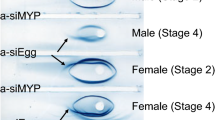Abstract
In the present study, we examined the localization of the major yolk protein (MYP) in the intestine of the sea urchin Strongylocentrotus intermedius. First, partial MYP complementary DNA was isolated from the sea urchin intestine. The expression level of MYP messenger RNA (mRNA) along the sea urchin digestive tract is highest in the intestine, so we performed in situ hybridization and immunohistochemical analysis using this tissue. No MYP mRNA was detected in the luminal epithelium, connective tissue, muscle tissue, or coelomic epithelium by in situ hybridization analysis. Positive immunohistochemical staining was observed in the luminal epithelium, inner epithelium and connective tissue, the signal being strongest in the latter. We conclude that MYP synthesized in the inner epithelial cells is moved to and stored in connective tissue and the luminal epithelium, before being secreted into the body cavity and the inner digestive cavity of the sea urchin.







Similar content being viewed by others
References
Harrington FE, Easton DP (1982) A putative precursor to the major yolk protein of the sea urchin. Dev Biol 94:505–508
Kari BE, Rottmann WL (1985) Analysis of changes in a yolk glycoprotein complex in the developing sea urchin embryo. Dev Biol 108:18–25
Yokota Y, Kato KH (1988) Degradation of yolk proteins in sea urchin eggs and embryos. Cell Differ 23:191–199
Giga Y, Ikai A (1985) Purification of the most abundant protein in the coelomic fluid of a sea urchin which immunologically cross reacts with 23S glycoprotein in the sea urchin eggs. J Biochem 98:19–26
Giga Y, Ikai A (1985) Purification and physical chemical characterization of 23S glycoprotein from sea urchin (Anthocidaris crassispina) eggs. J Biochem 98:237–243
Wang H, Ura K, Takagi Y (2015) The major yolk protein in sea urchin egg yolk granules is a glycoprotein complex. Fish Sci 81:1127–1134
Shyu AB, Raff RA, Blumenthal T (1986) Expression of the vitellogenin gene in female and male sea urchin. Proc Natl Acad Sci USA 83:3865–3869
Unuma T, Suzuki T, Kurokawa T, Yamamoto T, Akiyama T (1998) A protein identical to the yolk protein is stored in the testis in male red sea urchin, Pseudocentrotus depressus. Biol Bull 194:92–97
Unuma T, Ikeda K, Yamano K, Moriyama A, Ohta H (2007) Zinc-binding property of the major yolk protein in the sea urchin—implications of its role as a zinc transporter for gametogenesis. FEBS J 274:4985–4998
Unuma T, Okamoto H, Konishi K, Ohta H, Mori K (2001) Cloning of cDNA encoding vitellogenin and its expression in red sea urchin Pseudocentrotus depressus. Zool Sci 18:559–565
Brooks JM, Wessel GM (2002) The major yolk protein in sea urchins is a transferrin-like, iron binding protein. Dev Biol 245:1–12
Yokota Y, Unuma T, Moriyama A, Yamano K (2003) Cleavage site of a major yolk protein (MYP) determined by cDNA isolation and amino acid sequencing in sea urchin, Hemicentrotus pulcherrimus. Comp Biochem Physiol 135B:71–81
Hayley M, Sun M, Merschrod SEF, Davis PJ, Robinson JJ (2008) Biochemical analysis of the interaction of calcium with toposome: a major protein component of the sea urchin egg and embryo. J Cell Biochem 103:1464–1471
Unuma T, Nakamura A, Yamano K, Yokota Y (2010) The sea urchin major yolk protein is synthesized mainly in the gut inner epithelium and the gonadal nutritive phagocytes before and during gametogenesis. Mol Reprod Dev 77:59–68
Iimura K, Tohse H, Ura K, Takagi Y (2012) Expression patterns of runx2, sparc, and bgp during scale regeneration in the goldfish Carassius auratus. J Exp Zool 318:190–198
Takagi Y (2000) Ultrastructural immunolocalization of the otolith water-soluble-matrix in the inner ear of rainbow trout just-hatched fry. Fish Sci 66:71–77
Scott LB, Lennarz WJ (1989) Structure of a major yolk glycoprotein and its processing pathway by limited proteolysis are conserved in echinoids. Dev Biol 132:91–102
Ozaki H, Moriya O, Harrington FE (1986) A glycoprotein in the accessory cell of the echinoid ovary and its role in vitellogenesis. Roux’s Arch Dev Biol 195:74–79
Noll H, Alcedo J, Daube M, Frei E, Schiltz E, Hunt J, Humphries T, Matranga V, Hochstrasser M, Aebersold R, Lee H, Noll M (2007) The toposome, essential for sea urchin cell adhesion and development, is a modified iron-less calcium-binding transferrin. Dev Biol 310:54–70
Unuma T, Konishi K, Kiyomoto M, Matranga V, Yamano K, Ohta H, Yokota Y (2009) The major yolk protein is synthesized in the digestive tract and secreted into the body cavities in sea urchin larvae. Mol Reprod Dev 76:142–150
Unuma T, Sawaguchi S, Yamano K, Ohta H (2011) Accumulation of the major yolk protein and zinc in the agametogenic sea urchin gonad. Biol Bull 221:227–237
Finkelstein RA, Sciotino CV, McIntosh MA (1983) Role of iron in microbe-host interactions. Rev Infect Dis 5(Supp 4):S759–S777
Gray-Owen SD, Schryvers AB (1996) Bacterial transferrin and lactoferrin receptors. Trends Microbiol 4:185–191
Guz N, Kilincer N, Aksoy S (2012) Molecular characterization of Ephestia kuehniella (Lepidoptera: Pyralidae) transferrin and its response to parasitoid Venturia canescens (Hymenoptera: Ichneumonidae Gravenhorst). Insect Mol Biol 21:139–147
Suzumoto BK, Schreck CB, McIntyre JD (1977) Relative resistances of three transferrin genotypes of coho salmon (Oncorhynchus kisutch) and their hematological responses to bacterial kidney disease. J Fish Res Bd Canada 34:1–8
Acknowledgements
We thank Dr. P. M. Lokman, Department of Zoology, University of Otago for critically reading the manuscript. Thanks are also due to Dr. Hiroyuki Munehara, Usujiri Fisheries Station, Field Science Center for the Northern Biosphere, Hokkaido University, for providing samples and helpful advice.
Author information
Authors and Affiliations
Corresponding author
Rights and permissions
About this article
Cite this article
Okashita, Y., Wang, H., Tsue, S. et al. Localization of major yolk protein in the digestive tract of the sea urchin Strongylocentrotus intermedius . Fish Sci 83, 803–810 (2017). https://doi.org/10.1007/s12562-017-1118-9
Received:
Accepted:
Published:
Issue Date:
DOI: https://doi.org/10.1007/s12562-017-1118-9




